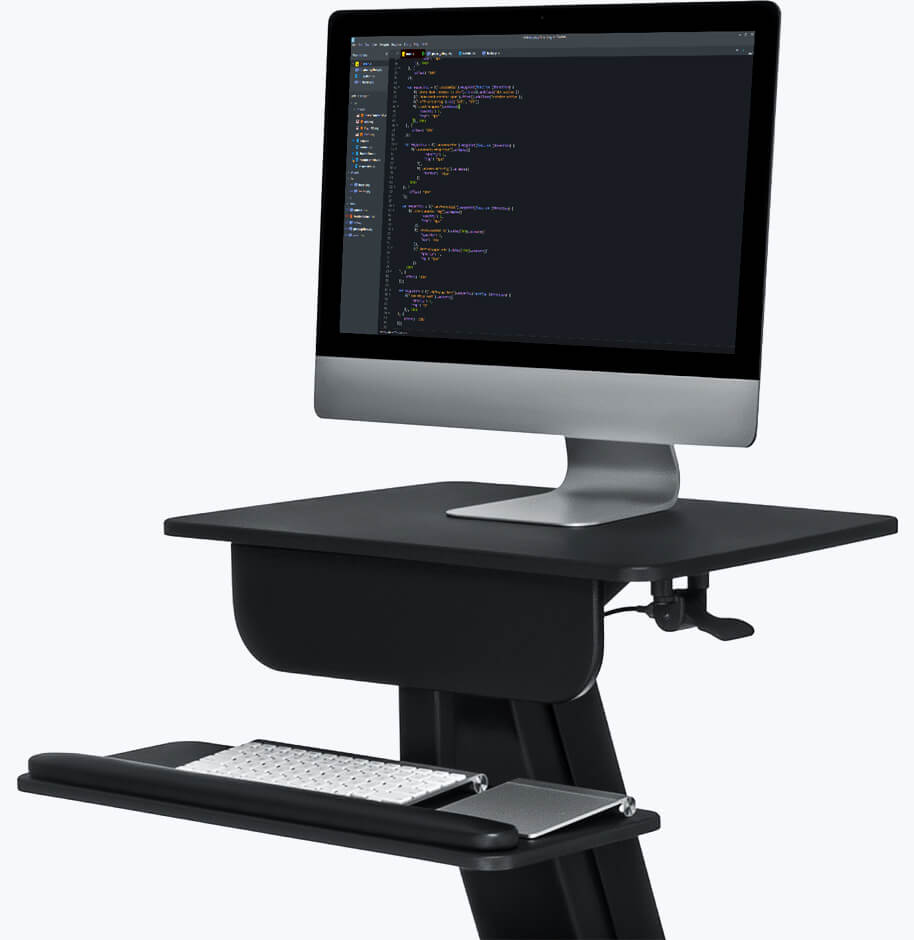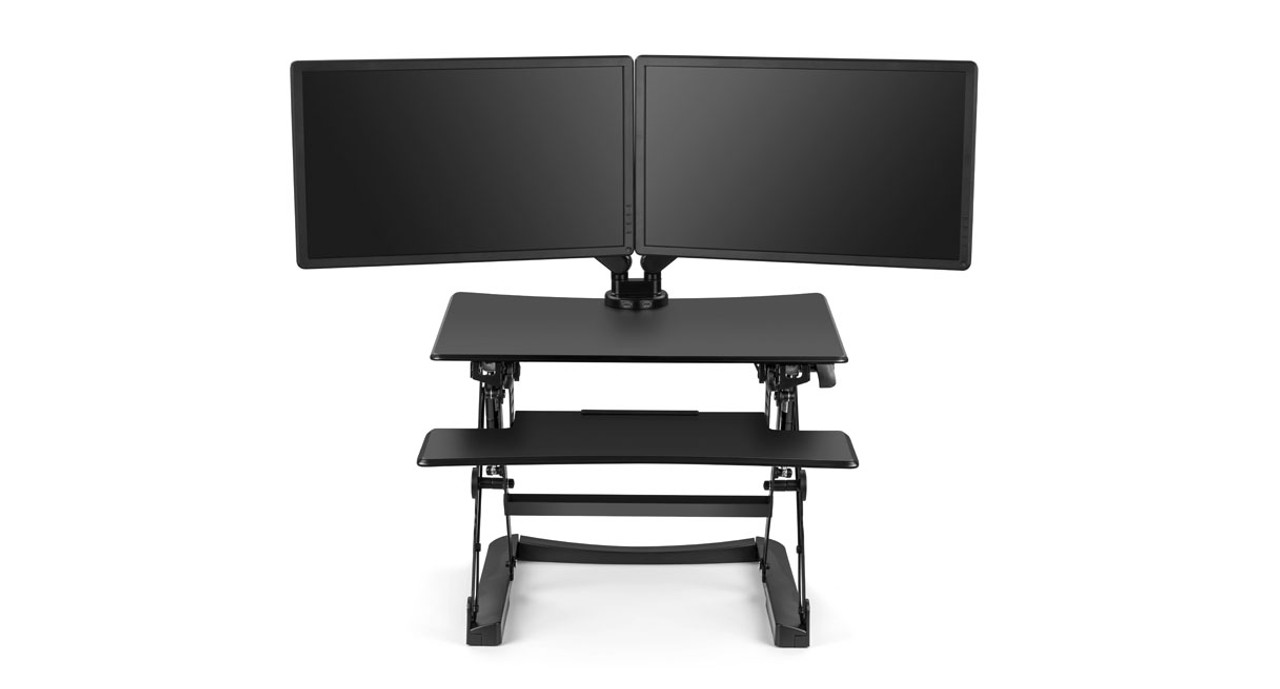
- UPLIFT STANDING DESK CONVERTER MANUAL
- UPLIFT STANDING DESK CONVERTER FULL
- UPLIFT STANDING DESK CONVERTER PRO
- UPLIFT STANDING DESK CONVERTER PLUS
Two-tier converters, by contrast, keep the keyboard tray and the monitor platform at a fixed distance.

UPLIFT STANDING DESK CONVERTER PRO
By offering adjustments to the heights of the monitor and the work surface individually, the Kangaroo Pro Junior’s design accommodates more people with different torso and arm heights.
UPLIFT STANDING DESK CONVERTER PLUS
You can raise the monitor and work surface exactly where you need them, as opposed to being limited to the increments of an electric device or the notches of the VariDesk Pro Plus 30.Looks: Appearances are not a strength for almost every model we’ve tested, but if a converter does anything to distinguish its appearance or hide some of its raising mechanisms, we note that.
UPLIFT STANDING DESK CONVERTER MANUAL
This matters to a lesser extent for the manual two-tier models and single-column models, whose size and weight make stashing them a challenge.
Weight: For the single-platform models we test, this is an important factor that allows you to easily remove your converter if you need the surface for other things, such as if you’re working on a kitchen table or dining room table. We’ve dismissed some desks based on noise, though they’ve usually had other problems, as well. Noise: This factor is mostly a consideration for electric models, but some manual converters also make groans, unsettling motor noises, or even screeching metal-coil-bending sounds when moving. UPLIFT STANDING DESK CONVERTER FULL
The full standing desks we test are 30 inches deep, and any converter that comes too close to that (or goes over) is not useful to most people.
Desk depth: We look for converters that can fit a 30-inch-deep desk, since that’s the size of typical desks. That doesn’t seem like much, but some people may not be able to raise their chair to meet that height while still keeping their feet flat on the floor, as ergonomic experts recommend. A thick converter work surface may raise your typing surface more than 2 inches off the desk you are using. Minimum height: This measurement, which refers to how far the converter unit raises your work surface over the original height of a desk or table, is a major consideration. We dismiss models that fall notably short of this goal, with the exception of the inherently compromised laptop risers. Most full-size desks we’ve recommended accommodate people with heights up to 6-foot-2, give or take an inch or two. Maximum height: A converter should accommodate as many human heights as possible. We prefer flat rectangular surfaces over those with unnecessary cutouts that waste space. Space and layout: Although converters and desks come in different sizes, we think any standing desk option should have optimal space for a keyboard and mouse, as well as a few other items such as a mug, a medium-size notebook, and a pen. 
Poor options place their keyboard surface too close to where your screen is or force you to raise your hands to reach your keys while you’re sitting.
 General ergonomics: The way a converter is built should allow you to stand about an arm’s length away from your screen, with your elbows bent at a 90-degree or greater angle. We prefer electric converters that offer collision detection, stopping the desk from continuing to move if it faces resistance. Less likelihood of pinching or crushing: A standing desk converter’s moving parts shouldn’t catch your hands or snag a cable. In either case, we consider whether it would be aggravating to have to make that move multiple times per day. (For reference, in our latest round of testing, our tester was a 5-foot-2, 130-pound writer who doesn’t do a lot of strength training.) For electric models, we consider how long a desk takes to move and how difficult it is for us to make fine adjustments. Ease of raising and lowering: For manually controlled models, we consider how much strength or finesse is required. For units with monitor mounts, positioning your monitor at eye level should be as easy as lifting your work surface to elbow height. You should be able to lock your work surface at just the right height instead of having to settle for a small number of preset heights that might not be appropriate for you.
General ergonomics: The way a converter is built should allow you to stand about an arm’s length away from your screen, with your elbows bent at a 90-degree or greater angle. We prefer electric converters that offer collision detection, stopping the desk from continuing to move if it faces resistance. Less likelihood of pinching or crushing: A standing desk converter’s moving parts shouldn’t catch your hands or snag a cable. In either case, we consider whether it would be aggravating to have to make that move multiple times per day. (For reference, in our latest round of testing, our tester was a 5-foot-2, 130-pound writer who doesn’t do a lot of strength training.) For electric models, we consider how long a desk takes to move and how difficult it is for us to make fine adjustments. Ease of raising and lowering: For manually controlled models, we consider how much strength or finesse is required. For units with monitor mounts, positioning your monitor at eye level should be as easy as lifting your work surface to elbow height. You should be able to lock your work surface at just the right height instead of having to settle for a small number of preset heights that might not be appropriate for you. 
Adjustability: This is a key factor for ergonomics.








 0 kommentar(er)
0 kommentar(er)
